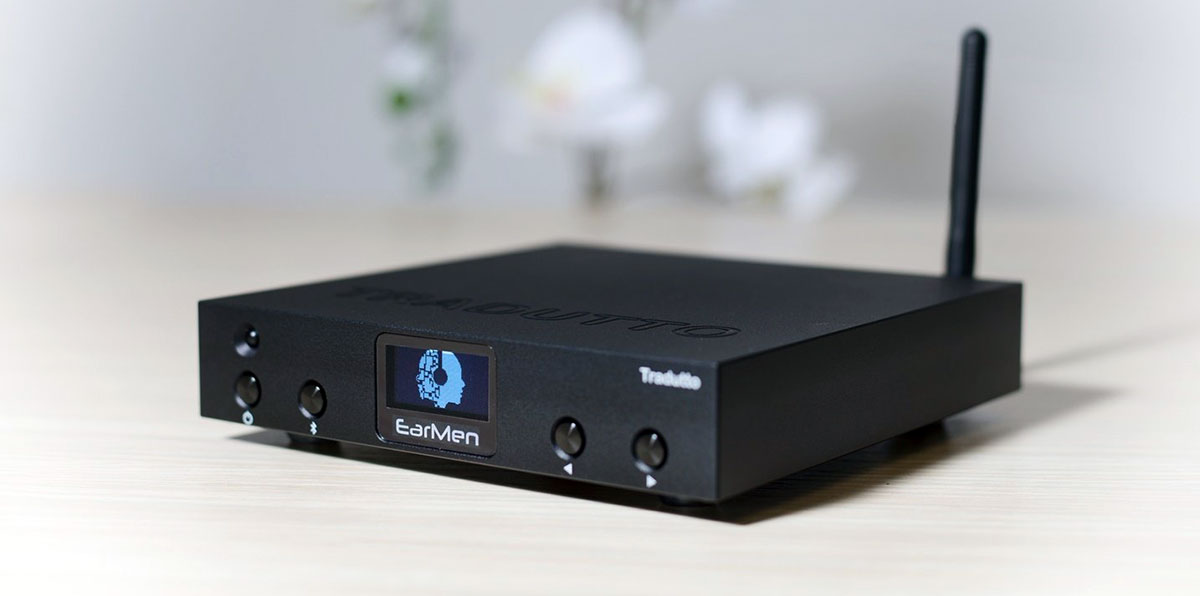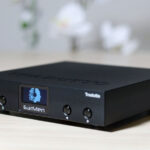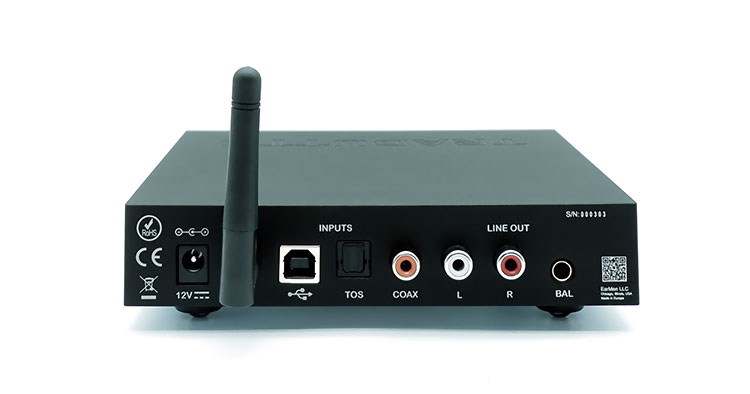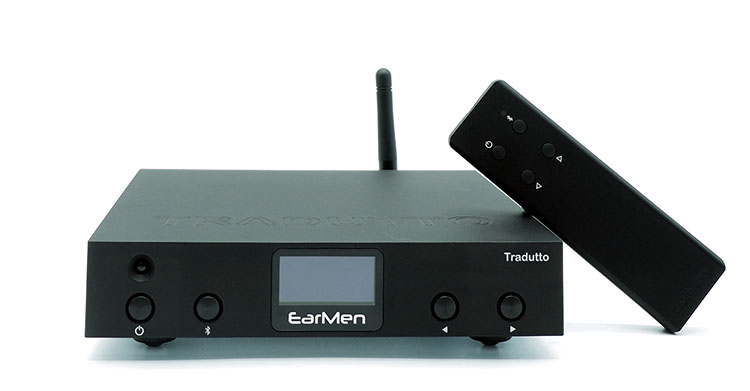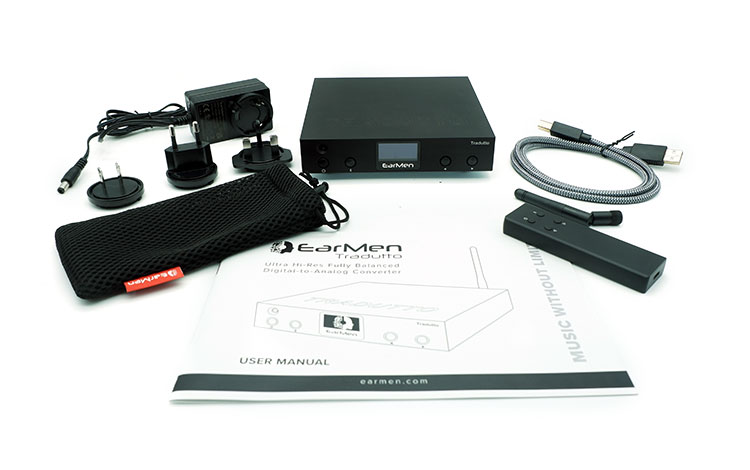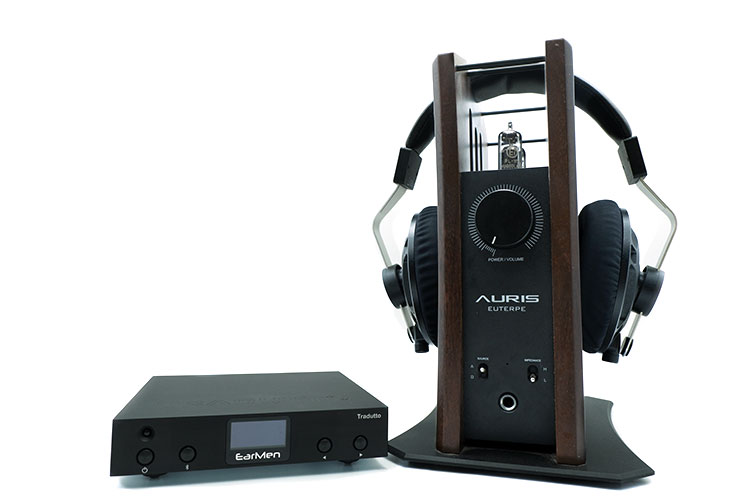The EarMen Tradutto is a fully balanced desktop DAC featuring an ES9038Q2M DAC, MQA, and Bluetooth wireless capability. It is priced at $799.
Disclaimer: The EarMen Tradutto sent to us is a sample in exchange for our honest opinion in this review. We thank EarMen for this opportunity.
To learn more EarMen reviews on Headfonics you can click here.
Note, this review follows our new scoring guidelines for 2021 which you can read up on here.
As a brand, EarMen is fairly new, but the sister company Auris Audio has been an established manufacturer of tube amplifiers for quite a while now. Since their early releases, we’ve had the privilege to take a closer look at EarMen’s products such as the TR-Amp, Sparrow, and the Donald DAC.
However, most of these products were geared more toward portable and transportable applications. This time, EarMen has released a larger balanced desktop DAC called the Tradutto, which means translator in Italian.
Judging from the PR releases from recent audio shows, this may be the first of a series of modular desktop devices with what seems to be a matching headphone amp and power supply on the way also.
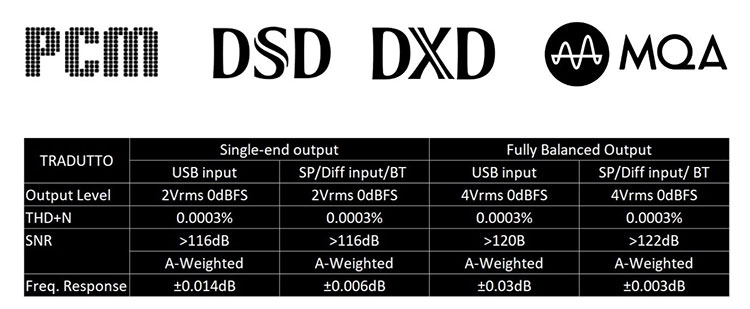
Tech Highlights
Based on the specs sheet, the Tradutto is equipped with an ESS ES9038Q2M DAC, and I’m sure some who are fans of the SMSL SU-9 might be up in arms knowing that a DAC around twice the price doesn’t even use an ES9038 Pro DAC.
However, EarMen explains that they have minimized the current drawn by the Tradutto to be able to reduce the interference from Bluetooth, WiFi, or cellular signals.
Upstream to the ES9038Q2M is an XMOS SU216 USB controller chip, which allows the Tradutto to decode 32BIT/768Khz PCM, DSD512, and unfold MQA files. Aside from wired inputs, the Tradutto is also equipped with a QCC5124 Bluetooth receiver chip, which runs Bluetooth 5.1 with AAC, SBC, and aptX/LL/HD decoding capability.
Internally, the analog and digital sections are properly isolated to ensure that noise won’t leak through. To further reduce the THD on the Tradutto, EarMen used MELF low noise resistors and Soundplus OPA1642 op-amps. This results in a THD+N or 0.0003% through the balanced outputs.
Aside from reducing THD, EarMen has paid careful attention to the clock circuitry to reduce jitter. Using both a low THD+N and an accurate clock creates a black background while making timing information as accurate as possible.
Design
At first glance, the Tradutto is a small DAC, but don’t let its size fool you since it’s heavier than I expected it to be.
The entire chassis except for the bottom plate of the Tradutto is made of aluminum finished in an industrial-looking matte black finish while the word Tradutto is etched on top of the chassis. The bottom plate is made of a galvanized iron sheet that has vents that were punched, giving it rough edges, a laser-cut metal sheet would have made it smoother.
On the front fascia, there are 2 buttons on each side, and a screen in the middle, which makes it symmetrical except for the IR receiver above the power button. Next to the power button is the Bluetooth pairing button, then the screen is located in the center of the device.
The screen is used to indicate the input currently being used except for USB where the file type and sampling rate will be shown. Switching between the available inputs is done using the left and right buttons with the sequence USB->Toslink->Coaxial->Bluetooth which only goes 1 way, so it won’t cycle through.
I/O
Despite the smaller frame, the input options on the Tradutto are versatile enough by today’s standards. Of course, the Tradutto has a full USB B input together with the more traditional Coaxial and Toslink input, and an option to use the DAC as a Bluetooth 5.1 receiver.
All I/O is housed at the rear panel. Despite the compact size, it never gets crowded even when you opt to use all the input and output options. That’s mainly because the balanced output uses a 4.4mm balanced output similar to what we’ve seen with the ifi Zen DAC/Can.
When it comes to the outputs, the Tradutto is also competitive in today’s market, allowing for both single-ended RCA outputs and a 4.4mm pentaconn balanced output. However, both outputs are fixed outputs, since there is no pre-amp functionality inside the Traudtto.
Controls
Being a plain DAC, the controls that are available on the Tradutto are very simple. The only available controls are for power, Bluetooth pairing, and input selection.
Although there isn’t much else in terms of options, the Tradutto also provides a well-built remote control that has the same options as the buttons available in front of the device.
The remote has 4 buttons, so it exactly mimics the functions of the buttons in front of the device. What’s interesting with the remote though is that it’s pretty heavy, and there is no battery cover, instead, it has a USB C to recharge the internal battery.
One thing to note with the Tradutto though is that it doesn’t retain any memory of the last input being used prior to turning it off. So if will go back to the default input, which is USB, every time that it is turned on.
Packaging & Accessories
When the box for the Tradutto arrived with me, I was impressed with how heavy and well packaged the Tradutto is.
The first thing that you would see is the outer sleeve that shows some EarMen branding, and a picture of the DAC, as well as some specs. Once the outer sleeve is removed, there is a hard box with a magnetic flap that makes the package both sturdy and easy to open.
Once inside the box, there are foam inserts that keep the DAC from being crushed during transport and storage. The foam is a bit softer than I expected though, but I can see that it will do the job well enough.
Underneath the DAC is a compartment that contains all the accessories. That includes the Bluetooth aerial, a USB cable, and the switchmode power supply that comes package in a mesh bag together with different style plugs that will suit your region.
Sound Impressions
Summary
One way to describe the Tradutto is that it tends to create a rounded and full-bodied presentation. Despite being full-bodied, there is still a sense of crispness in its detail retrieval capability when called for.
Something impressive though is that despite having a warmer tilt, the Tradutto maintains control over the entire frequency spectrum. This results in an enjoyable and detailed presentation that stays safely away from being sibilant.
Timbre
The sub-bass is extended well, any roll-off will be left to any downstream gear that may introduce it. Although it is not particularly emphasized, it won’t easily get lost in the mix as it has an environmental feel something akin to a well-placed subwoofer in the room.
There is an ample amount of mid-bass, but there is no perceived bloat. There is also a good amount of heft and body that gives notes a certain level of physicality to them. Surprisingly, the thickness in the mid-bass doesn’t make the bass sluggish. Mid-bass instruments such as drums are powerful and natural while being rounded and controlled.
Midbass instruments are also textured, which allows a clearer depiction of drum cavities while making a distinction between the materials that are used to hit the drums. Similarly, with bass guitars, each pluck has a flowy character when called for, while individual notes don’t blend.
The vocal presentation with the Tradutto is thick and rich, however, there isn’t much in terms of euphony into the vocal range, as the Tradutto tends to be more honest in this respect.
Similarly, with guitars and pianos, the tone of both instruments lean towards a warmer presentation. Guitar plucks are thick and authoritative, but the warmer tilt also translates to less sweetness in the tone of most midrange instruments.
Although treble is still present, it remains well controlled where leading edges of notes are crisp while maintaining a natural amount of shimmer, but it never goes into being offensively bright. Treble is well extended, but not particularly emphasized, so there isn’t much in the way of exaggerated airiness.
Staging & Dynamics
Despite the lack of artificially injected airiness, the images within the soundstage can easily be discerned. Imaging is accurate, particularly in the lateral direction.
The soundstage itself on the other hand is wide enough, and there doesn’t seem to be a wall that serves as the boundary of the soundstage. Instead, the soundstage recreated by the Trudutto is faithful to the soundstage that is available in the track, to begin with.
The more forward presentation of the Tradutto makes most of the instruments feel closer to the listener so some tracks that may emphasize vocals will end up competing with surrounding instruments for space and your listening attention.
With the more forward presentation of the Tradutto, the dynamic range is less emphasized. This ends up making the softer tones a bit louder than I expected them to be, but the Tradutto surprisingly brings on a lot of energy when the track calls for it.
Bluetooth Performance
The Bluetooth connection retains most of the tonal balance of the DAC. This means that it’s still thick and controlled with a warmer tilt. However, the biggest difference is in the detail retrieval capability which is an inherent limitation of Bluetooth protocols, as it’s comparatively less detailed.
Due to being a step back in detail retrieval, the Bluetooth connection on the Tradutto also ends up creating less delineated imaging while pushing most of the images even more forward. This results in having more of a wall of sound effect, particularly when it’s compared to the Tradutto wired connection.
Synergy
Pairings
The Tradutto can easily play well with most gear without creating an overly bright chain. However, throughout my testing, there have been some setups that ended up a bit too warm for the details to shine through properly. There are 2 amplifiers that I believe paired exceptionally well with the Tradutto.
The first amplifier is the SMSL’s HO200 amplifier together with the Hifiman Ananda. This pairing allowed the Tradutto to warm up the cooler presentation of the HO200 resulting in a detailed but still full-bodied presentation. Plugging in the Ananda then introduces a wider soundstage allowing some of the images to breathe more easily within the soundscape.
Another amplifier that I tried with the Tradutto is an amplifier from its sister company, the Auris Audio Euterpe. The pairing with this amplifier creates a more euphonic vocal presentation while giving midrange instruments a comparatively more balanced tilt. Another benefit that Euterpe brings to the table is the added soundstage depth allowing images to be much more layered.
With this pairing, I plugged in my Sennheiser HD600, which allows for a more euphonic midrange presentation. The wider soundstage introduced by the Euterpe, coupled with the controlled presentation of the Tradutto allows the HD600 to shine while introducing better delineation of images within the soundscape.
The most enjoyable headphone with this pairing though is the Final D8000, where the dynamic quality of the D8000 and ultimate control is maintained by the amp and DAC.
Also, the D8000 introduces a layer of sweetness to the midrange presentation. The more layered and wider soundstage of the signal chain also allows the D8000 to truly express the musicality and delineation of the images within the soundscape.
Click on page 2 below for select comparisons

